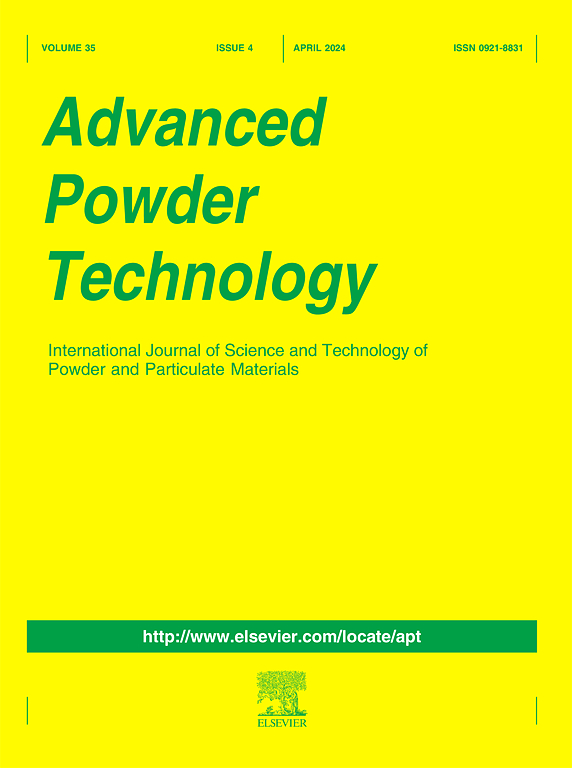Box Behnken design-based optimized green synthesis of lanthanum oxide submicroparticles using Quercus Infectoria galls extract and their antimicrobial activities
IF 4.2
2区 工程技术
Q2 ENGINEERING, CHEMICAL
引用次数: 0
Abstract
This study focuses on the green synthesis of lanthanum oxide submicroparticles (LO-SMPs) using the galls extract of Quercus Infectoria. Response surface methodology (RSM) based optimization using Box-Behnken design (BBD) was performed and a linear model was found to be best fitted and was used to evaluate the influence of time, the concentration of salt and volume of the extract on the synthesis of LO-SMPs. The optimized conditions for the synthesis were found to be 80 min, 2 mM and 12 mL with the absorbance of 1.74. ANOVA analysis reveals significant results based on their p-value. Synthesized LO-SMPs were characterized using various techniques such as UV–Vis, FTIR, SEM, EDX, XRD and DLS analysis. The morphology of LO-SMPs was analyzed using SEM and was found to be poly-dispersed spherical clusters. The body-centered cubic structure of LO-SMPs was confirmed by XRD. Furthermore, the nanoparticles inhibited three pathogenic microorganisms (S. aureus, E. coli, and P. multocida) and the inhibition potential of LO-SMPs showed enhanced activities compared to the plant extract. It was observed that high concentrations of LO-SMPs (30 mg/mL) showed a larger zone of inhibition against E. coli and P. multocida at 32 mm and 28 mm, respectively. The findings revealed that LO-SMPs have promising antibacterial activity, which might have potential as therapeutic agents, which need further investigation on the cytotoxicity and biocompatibility studies on cell lines.

Box Behnken基于设计优化了利用栎瘿提取物绿色合成氧化镧亚微粒及其抑菌活性
研究了以栎瘿提取物为原料绿色合成氧化镧亚微粒的工艺。采用Box-Behnken设计(BBD)进行响应面法(RSM)优化,发现线性模型最适合,并用于评估时间、盐浓度和提取液体积对LO-SMPs合成的影响。最佳合成条件为80 min, 2 mM, 12 mL,吸光度为1.74。方差分析显示基于p值的显著结果。采用UV-Vis、FTIR、SEM、EDX、XRD和DLS等技术对合成的LO-SMPs进行了表征。用扫描电镜分析了LO-SMPs的形貌,发现其为多分散球形团簇。用XRD证实了LO-SMPs的体心立方结构。此外,纳米颗粒抑制了三种致病微生物(金黄色葡萄球菌、大肠杆菌和多杀性假单胞菌),并且与植物提取物相比,LO-SMPs的抑制潜力增强。结果表明,高浓度(30 mg/mL)的LO-SMPs对大肠杆菌和多杀杆菌分别在32 mm和28 mm处有较大的抑制区。结果表明,LO-SMPs具有良好的抗菌活性,可能具有作为治疗药物的潜力,有待于进一步的细胞毒性和细胞系生物相容性研究。
本文章由计算机程序翻译,如有差异,请以英文原文为准。
求助全文
约1分钟内获得全文
求助全文
来源期刊

Advanced Powder Technology
工程技术-工程:化工
CiteScore
9.50
自引率
7.70%
发文量
424
审稿时长
55 days
期刊介绍:
The aim of Advanced Powder Technology is to meet the demand for an international journal that integrates all aspects of science and technology research on powder and particulate materials. The journal fulfills this purpose by publishing original research papers, rapid communications, reviews, and translated articles by prominent researchers worldwide.
The editorial work of Advanced Powder Technology, which was founded as the International Journal of the Society of Powder Technology, Japan, is now shared by distinguished board members, who operate in a unique framework designed to respond to the increasing global demand for articles on not only powder and particles, but also on various materials produced from them.
Advanced Powder Technology covers various areas, but a discussion of powder and particles is required in articles. Topics include: Production of powder and particulate materials in gases and liquids(nanoparticles, fine ceramics, pharmaceuticals, novel functional materials, etc.); Aerosol and colloidal processing; Powder and particle characterization; Dynamics and phenomena; Calculation and simulation (CFD, DEM, Monte Carlo method, population balance, etc.); Measurement and control of powder processes; Particle modification; Comminution; Powder handling and operations (storage, transport, granulation, separation, fluidization, etc.)
 求助内容:
求助内容: 应助结果提醒方式:
应助结果提醒方式:


